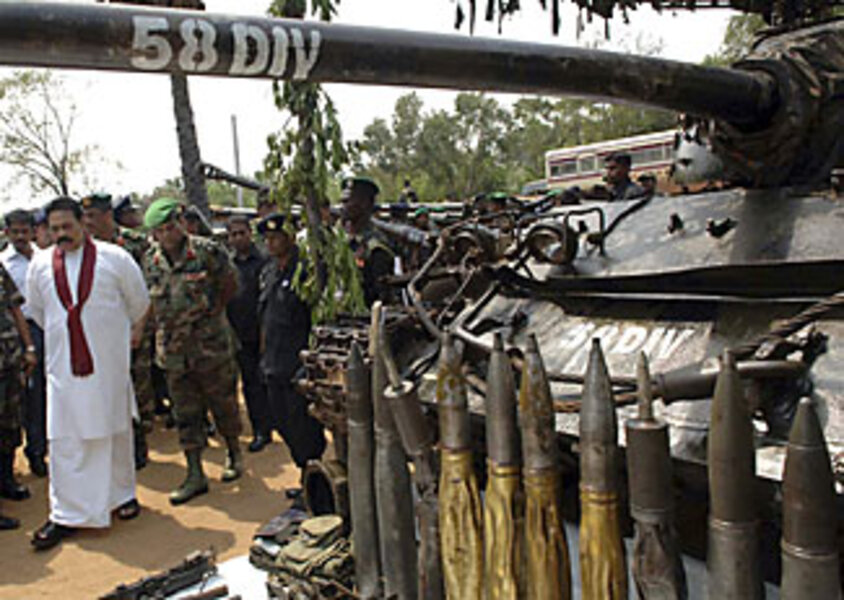Sri Lanka's Army, rebels resume battle near no-fire zone
Loading...
| Bangkok, Thailand
A 48-hour halt in Sri Lanka's military offensive against Tamil rebels, aimed at allowing tens of thousands of civilians to flee, ended Wednesday without success, fanning fears of an imminent violent showdown in the rebels' final redoubt.
United Nations humanitarian chief John Holmes called Wednesday for a longer pause to evacuate more civilians and deliver essential aid. He accused the separatist Liberation Tigers of Tamil Eelam (LTTE), which is calling for a foreign-mediated cease-fire, of preventing noncombatants from escaping to safety. France and Britain issued a joint statement Wednesday with similar demands on the two warring sides, and accused the rebels of using civilians as human shields. Only a few hundred were able to escape during the cease-fire.
Fighting resumed near a designated no-fire zone, a 7.7 square-mile strip of coastal land where around 100,000 Tamil civilians are sheltering, according to the UN. Sri Lanka says the number of civilians is closer to 50,000, and estimates that 1,000 LTTE fighters are holed up there.
Sri Lankan government officials argue that extending the pause would be futile as long as the LTTE refuses to release noncombatants. They say that past cease-fires have allowed the rebels to rearm and regroup. Instead, they say, the military will keep fighting and open more corridors for civilians to flee.
"The message is clear. They don't want to settle this peacefully. We'll have to try to pick them off with minimal harm to civilians," says Rajiva Wijesinha, a cabinet minister who heads Sri Lanka's Secretariat for Coordinating the Peace Process.
On its website, the Defense Ministry said Thursday that it was preparing to carry out "the world's largest hostage rescue operation" by a conventional army in modern times, without giving details.
The government has ridden a wave of popular support by retaking territory from the LTTE, which, until 2007, controlled large swaths of the country's north and east. After rapid gains in January, the military advance has slowed as rebels retreated into a shrinking patch of scrubland. The defiance of the LTTE and the plight of civilians trapped behind their lines has dampened talk of a rapid victory.
"They [the government] would like to draw a line under it and say that they have won," says Paikiasothy Saravanamuttu, executive director of the Center for Policy Alternatives in Colombo.
UN officials have accused Sri Lankan troops of repeatedly shelling the no-fire zone in violation of international law. Last month, the UN Commission for Human Rights estimated that 2,800 civilians had died and more than 7,000 been injured since Jan. 20. UN briefing papers and hospital staff reports obtained by the Monitor blame incoming artillery and mortar fire for mounting casualties in the beleaguered zone.
Sri Lanka's government denies shelling civilians and describes reporting from the area as pro-rebel propaganda. Independent verification of these claims is difficult as outsiders are barred, with the exception of the Red Cross, which is delivering aid and evacuating sick and wounded civilians by boat. Currently, Sri Lanka is housing about 65,000 civilians in government-run refugee camps.
The two-day humanitarian pause was declared Sunday and coincided with New Year holidays in Sri Lanka, whose Sinhalese majority are overwhelmingly Buddhist. The Tamil minority, in whose name the LTTE has fought for a separate state since 1983, is mostly Hindu and Christian.





